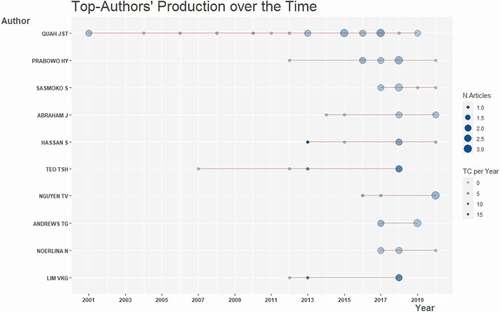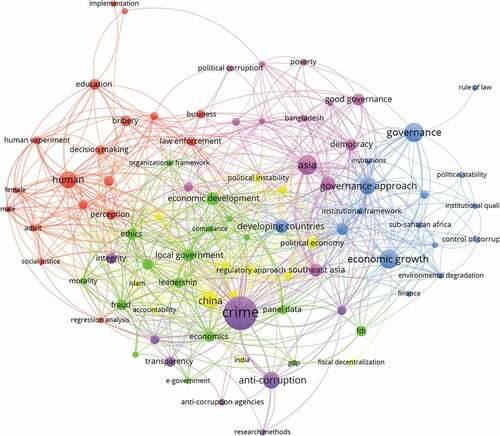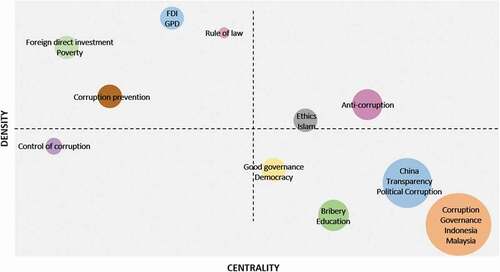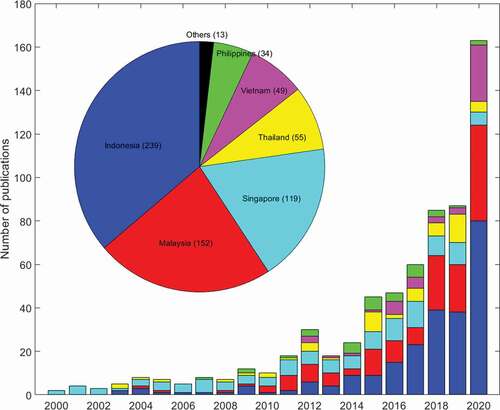Abstract
This article provides the first quantitative analysis on the development in the field of corruption research conducted by scholars having affiliations located in one of the ASEAN countries. Bibliometric analysis has been applied to a publication collection of 631 articles, published during the 2000–2020 period, in journals indexed in the Scopus database. Results showed that the number of publications has increased, especially during the 2011–2020 period with a share of 85.6% of the publication collection. The United States, the United Kingdom, China, the Netherlands and Hong Kong were the most important partner countries, but these collaboration projects accounted for only a small part of the publication collection. Collaboration between scholars in ASEAN countries was very limited, with many isolated scholars who have a few publications. The most popular research topics focused on corruption in a few sectors, such as education, economics, government, construction, and foreign direct investment. Findings in this article can be of interest to scholars who want to form a good vision of this research field in the future. Moreover, it might provide useful information to managers, decision-makers, and ASEAN governments on how to fight with corruption and improve transparency.
Keywords:
PUBLIC INTEREST STATEMENT
This paper collects and analyses meta-data of 631 publications related to corruption research, indexed in the Scopus database and published by scholars having affiliations located in one of Southeast Asian countries, to draw an overall picture of corruption research in this region over the last two decades. Bibliometric analysis has been used with support from bibliographic software such as VOSviewer and Biblioshiny to obtain this objective. Results show that 85.6% of publications were published during the 2011–2020 period. Among ten ASEAN states, Indonesia, Malaysia and Singapore published the highest number of papers in this field. The US, the UK, China, the Netherlands and Hong Kong were the most important partner countries, but the collaboration networks in this field among Southeast Asian countries, and between Southeast Asian countries with other partner countries were quite limited. The most popular research topics focused on corruption in education, economics, government, construction, and foreign direct investment.
1. Introduction
Corruption, defined by Transparency International, is the misuse of entrusted power for private gain. However, different disciplines have different definitions and understandings of corruption. Corruption defined by economists is a situation where the benefit to a corrupt agent of acting against the expectation of a principal outweighs the cost, or where a public good, service or office is sold for personal gain (Shihata, Citation1997). Political scientists defined corruption as “a symptom of more deeply rooted problems in the society’s structure related in particular to the means of attaining and maintaining power and the weak or non-existent safeguards against its abuse” (Johnston, Citation1986). Sociologists defined corruption as a “social relationship” in patron-client terms, a form of “patrimonialism” or an indicator of a dysfunctional society (Deflem, Citation1995). Corruption is a global problem, causing poverty, greed, unemployment, weak institutions, and non-enforcement, but it exists in every nation at different levels despite efforts by national and international controlling bodies (Bahoo, Citation2020). As a consequence, corruption also hampers a country’s economic development, and has negative impacts on investment, competition and government efficiency.
Corruption research in many disciplines has been available in the literature, for instance, in law (Mijares, Citation2015), finance (Pantzalis et al., Citation2008), economics (Brada et al., Citation2012), and accounting (Everett et al., Citation2007). Recently, several authors used bibliometrics method to analyze the development of corruption research in different fields such as corruption in economics (Bahoo et al., Citation2021), corruption in banks (Bahoo, Citation2020), corruption in healthcare organizations (Sforza et al., Citation2020), and corruption and entrepreneurship (Uribe-Toril et al., Citation2019). Bibliometrics analysis is a statistical and mathematical approach for analyzing scientific literature in order to identify research trends and evolution in time of a research direction (Pham-Duc, Tran, et al., Citation2020). It is also an effective approach for the quantitative investigation of scientific activities based on the form and content of scientific literature (Broadus, Citation1987). This method is very popular and has been applied in many other research fields (Ha et al., Citation2020; Hallinger & Chatpinyakoop, Citation2019; Li et al., Citation2020; Pham-Duc, Nguyen et al., Citation2020; Pham-Duc et al., Citation2021).
The Association of SouthEast Asian Nations (ASEAN) was established on 8 August 1967 in Bangkok, Thailand, by the five original member states: Indonesia, Malaysia, Philippines, Singapore, and Thailand. Since then, five other nations in the region have been admitted to ASEAN, including, Brunei in 1984, Vietnam in 1995, Laos and Myanmar in 1997, and Cambodia in 1999. Today, ASEAN has totally 10 member states. According to the Transparency International’s Corruption Perception Index (CPI) 2020, ASEAN hosts one of the cleanest countries—Singapore (with a score of 85 over 100), and one of the most highly corrupt countries—Cambodia (with a score of 21 over 100). Except Singapore, there are only two other ASEAN countries having the CPI greater than 50, namely Brunei (60) and Malaysia (51), respectively.
In this paper, bibliometric analysis is performed to explore the development and the richness of literature on corruption research conducted by scholars located in one of the ASEAN countries. To the best of our knowledge, this type of review is not yet available in the literature. Findings from this article will reveal the overall picture of corruption research conducted by scholars from ASEAN countries over the last two decades. This information can be of interest to researchers and research institutions to form a good vision for this research field in the years to come. In addition, it might provide useful information for managers, decision-makers, as well as ASEAN governments on how to fight with corruption and improve transparency. Our main research questions include:
What was the general information and the annual growth trend of publications related to corruption research conducted by scholars located in ASEAN countries over the last two decades?
What was the international collaboration network between ASEAN countries and other partner countries in this research field?
Which ASEAN countries, institutions and scholars published the most papers related to corruption research?
Which journals published the most papers related to corruption research conducted by scholars from ASEAN countries?
Which papers in the collection have had the most influence on the community in this research field?
What were the most important and popular research topics in this research field?
2. Data collection and methodology
2.1. Data collection
There are five main bibliographic databases that can be used to conduct a bibliometrics analysis, including: Web of Science (WoS), Scopus, Google Scholar, Microsoft Academic, and Dimensions (Moral-Muñoz et al., Citation2020). Among them, WoS and Scopus are used the most for bibliometrics analyses. In this study, we decided to use the Scopus database as the main search engine because it covers a wider range of documents than other databases (Mongeon & Paul-Hus, Citation2016; Pham-Duc, Tran et al., Citation2020).
2.2. The search query string
The search query string in Box 1 was applied in the Scopus database (Scopus Preview, Citation2021), on 10 April 2021. We searched all publications containing the keyword “Corruption” in the title or keywords (using functions TITLE and KEY), with at least one author having affiliation from one of the ASEAN countries (using function AFFILCOUNTRY). Document types were limited to articles, reviews, conference papers, and book chapters using function DOCTYPE. The search was limited to the 2000–2020 period, using the function PUBYEAR, as the number of publications related to corruptions research by scholars from ASEAN countries was very limited and discrete before 2000. Finally, all publications written in languages other than English were also excluded using function LANGUAGE.
Box 1. The search query string used in this study
2.3. Data cleaning and data processing
The output of the search query string in Box 1 was 662 publications. After scanning titles and abstracts of all 662 papers in the publication collection, we found that there were many papers that have been misclassified, especially papers classified into the Computer Science category. To filter these misclassified documents, publications containing keywords related to computer science were removed from the collection. The filtering keywords included noise corruption, data corruption, memory corruption, corruption recovery, image corruption, base corruption, web-based corruption, corruption bound, signal corruption, packet corruption, authority corruption, adaptive corruption, and burst corruption. After this step, the number of publications in the collection was reduced to 631.
Metadata of the final publication collection (n= 631) were exported to two different formats for post-processing in two most popular and effective bibliometrics analysis tools, BIB format for the Biblioshiny tool (Moral-Muñoz et al., Citation2020), and CSV format for the VOSviewer tool (van Eck & Waltman, Citation2010). Biblioshiny is an open-source tool for executing a comprehensive science mapping analysis of scientific literature. This tool was programmed in the R environment that provides the ability to be flexible and facilitate integration with other statistical and graphical packages, as well as the flexibility to be quickly upgraded and integrated. VOSviewer is a free Java tool, designed for analysing and visualizing citation networks of scientific collections. This tool displays the graphical representation of bibliometric maps and is especially effective for illustrating large bibliometric maps in an easy-to-interpret manner. Using both Biblioshiny and VOSviewer allows us to have a comprehensive overview on the scientific development of this research field, based on the number of published papers, the number of citations, h-index (Alavifard, Citation2015), collaboration networks of countries and authors, and co-occurrence network of keywords. Additional information on the Scopus website, and from the Scimago Journal & Country Rank (SJR, Citation2021) were also used to support to our analyses.
2.4. General information and growth trend
General information of the publication collection were summarized, and annual number of publications was analyzed to identify the growth trend of the research field. The study period was separated into two sub-periods, 2000–2010 and 2011–2020 for comparing the development in each sub-period.
2.5. Contribution by countries
Contribution by each country member based on numbers of papers and citations were analyzed to identify the most productive ones. In addition, evolution of annual publications in each country during the study period was also examined to provide an overview of the development of this research field in each country member.
2.6. International collaboration
VOSviewer tool was utilized for the analysis of international collaboration between ASEAN countries and partner countries in the field of corruption research. Countries with close collaboration were grouped into the same clusters, and the top 10 most productive partner countries outside ASEAN, based on numbers of papers and citations, were identified.
2.7. Contribution by institutions
The total number of research institutions publishing on corruption studies was identified and the top 10 institutions based on numbers of papers and citations were extracted.
2.8. Journal publishing
Core sources and the top 10 scientific journals publishing papers related to corruption studies from scholars from ASEAN countries were identified. Additional information about the top 10 publishing journals, for instance, numbers of papers and citations, Scimago scientific journal ranking, and Scopus journal quartile was collected to provide a general understanding about the quality of the publication collection.
2.9. Contribution by authors
Among all authors, the top 10 most productive ones based on number of publications were identified, along with their institutions/countries, and h-indexes. All citations of their papers in the collection and annual citations over the last five years were provided to analyze their influence within the community. VOSviewer was used to build the co-authorship network between all authors with at least three publications to generate the author collaboration network.
2.10. The most influential articles
Based on number of citations, the top 10 most cited papers were extracted, along with the evolution of its annual citations over the last decade. Biblioshiny tool was utilized to generate the historical direct citation network between the most important articles in the publication collection.
2.11. Keyword analysis
Co-occurrence network of 60 most popular keywords based on their frequency was generated using VOSviewer tool. This network is very useful in identifying important research themes on corruption studies in ASEAN over the last two decades. In addition, keywords that often appeared together in published papers were coded in the same colors and grouped in the same clusters.
2.12. Thematic map of research topics
Thematic maps of keywords (or research themes) were plotted using the Biblioshiny tool to classify all important research topics into four different quadrants based on the levels of centrality and density. The four quadrants classify keywords into popular research topics, developed and isolated research topics, emerging or declining research topics, and basic and transversal research topics.
3. Results
3.1. General information and growth trend
The most important information of the collection, its annual and cumulative numbers are shown in and . During the 2000–2020 period, there were totally 631 papers related to corruption studies by scholars from ASEAN countries, published in 362 different Scopus sources. The number of articles is dominant (—pie chart), with 507 papers (80.3%), followed by conference papers (50 papers, 8%), book chapter (47 papers, 7.4%), and reviewers (27 papers, 4.3%). There were totally 1435 authors in 631 papers, with 1782 author appearances. The number of single-authored documents is nearly one-third of the collection (191 papers, 30.3%). These single-authored papers were written by only 149 scholars (corresponds to 10% of the authors). On average, the document-to-author ratio was 0.44, the author-to-document and the co-author-to-document ratios were 2.27 and 2.82, respectively. With 4610 citations at the time of this study, each document has on average 7.3 citations.
Figure 1. Bar chart illustrates annual number of publications and its cumulative number on corruption research by ASEAN scholars. Pie chart illustrates percentage of document types of the collection
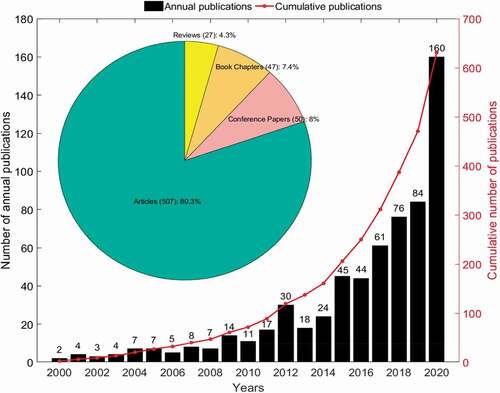
Table 1. Main information of the publication collection
The growth trend of the scientific output related to corruption studies by scholars from ASEAN can be divided into two sub-periods: 2000–2010 and 2011–2020 (—bar chart). The first period witnessed a very low production, with a total of 72 papers, and the annual number of publications was always lower than 10, except for 2009 (14 papers) and 2010 (11 papers). During the second period, the number of papers had increased steadily, with a total of 559 publications or a share of 85.6% (7.76 times higher than the first period). Except for 2020 with 160 papers (nearly doubled 2019 with 84 papers), the annual growth rate of the second period was 28.6%. The number of publications in 2020 was outstanding, comprising 28.6% of the publications of the second period, and 25.4% of the total publication collection.
3.2. Contribution by countries
As shown in —pie chart, among 631 papers in the publication collection, Indonesia had the biggest share (239 papers, 37.9%), followed by Malaysia (152 papers, 24%), Singapore (119 papers, 18.9%), Thailand (55 papers, 8.7%), Vietnam (49 papers, 7.8%), and Philippines (34 papers, 5.4%). The number of papers of the four remaining countries (Brunei, Cambodia, Myanmar, and Laos) was very limited (13 papers, 2%). Note that the sum of percentages of these countries exceeds 100% because a given paper can have co-authors from different countries. In terms of number of citations, Singapore was in the first position with 1542 citations, followed by Indonesia and Malaysia with 1113 and 1019 citations. The second group contains three countries with more than 300 citations, including Thailand (657 citations), Vietnam (539 citations) and the Philippines (305 citations). Numbers of citations of Myanmar, Laos, Brunei, and Cambodia were 180, 172, 54, and 21, respectively. Although Myanmar and Laos had limited number of publications, their numbers of citations were high because scholars from these two countries participated in a study of Fake anti-malarials in Southeast Asia with 169 citations at the time of this study (Dondorp et al., Citation2004).
Figure 2. Bar chart illustrates annual number of publications on corruption studies by ASEAN nations. Pie chart illustrates percentage of document by ASEAN nations
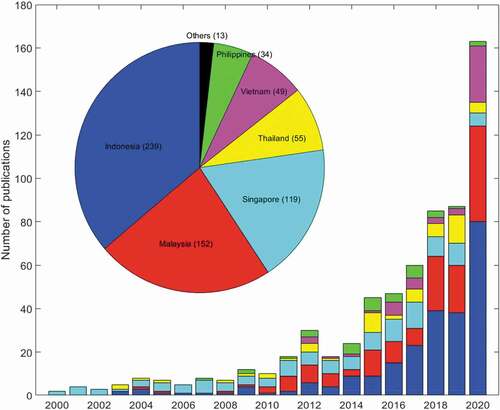
The evolution of annual publication of the top six countries is shown in —bar chart. Singapore (cyan) was in the third position in the number of publications, but published the very first papers related to corruption research about the development of judicial reform and judicial corruption in China (Keyuan, Citation2000). In addition, Singapore has the longest and most continuous publication history as they had at least 1 paper per year. Indonesia (blue) has the highest number of papers, but the first one was published only in 2003, about illegal logging and collusive corruption in Kalimantan, Indonesia (Smith et al., Citation2003). Since then, the number of papers on corruption from Indonesia has remained low until 2011, when it started to increase gradually during the second period, with an annual growth rate of nearly 40%. The publication development in Malaysia (red) was similar to that in Indonesia with the first paper studying corruption and accounting frauds published in 2004 (Seetharaman et al., Citation2004). However, until 2010, the publication growth of Malaysia rose slowly and reached 44 papers in 2020. The publication growths of Thailand (yellow), Vietnam (pink) and the Philippines (green) were not clear as they varied from one year to the other. However, the number of papers from Vietnam published in 2020 (26 papers) is notable as it accounts for 53% of publications from Vietnam in the collection.
3.3. International collaboration
Statistics from the Scopus database showed that 10 ASEAN nations have international collaboration with 59 other countries/regions to publish the collection of 631 papers. The cooperation network between all partner countries/regions (with at least two papers related to corruption research) is shown in . These countries/regions are grouped into six different clusters where each node indicates one country and the position of a country within the constellation represents how frequent their co-occurrence was with other countries. The size of the circles is proportional to the number of publications, and the thickness of lines between nodes is proportional to their collaboration strength, which was identified by the number of their co-authored publications (Pham-Duc, Tran et al., Citation2020). Indonesia and Vietnam formed one cluster (blue) having close collaboration with the United States (US), France, Australia, and Taiwan. Singapore and Thailand are in another cluster (yellow) having strong collaboration with China, Hong Kong and South Korea. The Philippines has many collaborations with the United Kingdom (UK), German, Italy, the Netherlands, Norway and Japan, while Malaysia built strong collaboration with Pakistan, Turkey, Iraq and Bangladesh.
Figure 3. International cooperation network between ASEAN countries and partner countries (at least two papers) on corruption research. The size of the nodes indicates the number of publications, while the thickness of the lines between nodes shows the strength of collaboration. Artwork generated with VOSviewer tool
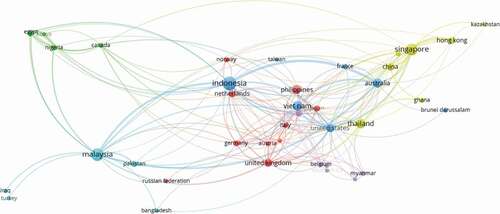
The top five most productive partner countries/regions with ASEAN nations on corruption research include the US, the UK, China, the Netherlands, and Hong Kong. The US ranked first with 32 collaboration papers and 606 citations, followed by the UK with 26 collaboration papers and 463 citations. With 19 collaboration papers and 178 citations, China was in the third position. Finally, the Netherlands and Hong Kong both have 12 collaboration papers, but the Netherlands was in the fourth position as it has 228 citations, compared to 201 citations from Hong Kong. Japan, German, New Zealand, Pakistan and Nigeria were next in the list of the top 10 most productive partner countries, but these countries all have fewer than 10 collaboration papers in this field of research with ASEAN countries.
3.4. Contribution by institutions
According to our retrieved Scopus database, the collection of 631 papers were published by a total of 1107 different organizations, and the top 10 most productive institutions based on the number of publications were all from the top three countries: Singapore, Malaysia, and Indonesia. More details are shown in . Of these 10 institutions, two were located in Singapore, three in Indonesia, and five in Malaysia. National University of Singapore ranked first, with outstanding scientific research results related to corruption studies: 73 papers (11.57%) and 702 citations (15.23%). The numbers of papers and citations from the National University of Singapore were 2.4 and 3.1 times higher than those from University Utara Malaysia in the second position (30 papers (4.75%) and 226 citations (4.90%)). University Indonesia was in the third position with 27 papers (4.28%) and 177 citations (3.84%). The last representative of Singapore in the top 10 was Nanyang Technological University in the fourth position, with 23 papers (3.64%) and 332 citations (7.2%). The remaining six institutions in the top 10 were both from Malaysia (4) and Indonesia (2), with fewer than 20 papers and 100 citations for each institution. Top 10 institutions published more than one-third of the collection (234 papers or 37%). Two representatives from Singapore were in the first two positions based on the number of citations per document: Nanyang Technological University and National University of Singapore averaging 14.43 and 9.62 citations per document.
Table 2. Top 10 most productive institutions in ASEAN countries publishing on corruption research based on total number of publications
3.5. Journals publishing
As shown in , the collection of 631 papers were published in 362 difference sources, and the top 10 most active journals publishing papers related to corruption studies from ASEAN countries is shown in . Journal of Financial Crime (JFC) published the most papers (25), followed by International Journal of Innovation Creativity and Change (IJICC) with 18 papers, International Journal of Psychosocial Rehabilitation (IJPR) with 16 papers, Asian Education and Development Studies (AEDS) with 14 papers, and Crime Law and Social Change (CLSC) with 10 papers. The remaining five journals in the top 10 published between 6 and 9 papers during the study period. The top 10 journals published totally 121 papers which corresponds to 19.2% of the publication collection. Among the top 10 journals, two belong to the Q1 quartile, two to the Q2 quartile, two to the Q3 quartile, and four discontinued in Scopus (according to classification from the Scimago Journal & Country Rank 2020). Considering the number of citations, Journal of Business Ethics ranked first with 291 citations, followed by CLSC with 135 citations. IJSTR and BIES ranked ninth and tenth based on number of papers, but were in the third and fourth positions based on number of citations. With 75 and 47 citations, AEDS and JFC were in the fifth and sixth positions. The number of citations of the four other journals in the top 10 was insignificant, especially, IJICC with 18 papers but having 0 citations at the time of this study. Bibliographic coupling among these top 10 journals is illustrated in , showing four different groups. The first group includes five journals: JFC, IJSTR, IJICC, IJPR, and BIES. The second group includes Crime, Law and Social Change and AEDS, while the third group contains IJABER and IJCS. Journal of Business Ethnics forms the last group.
Figure 4. Bibliographic coupling among the most active journals publishing research related to corruption studies from ASEAN countries. Artwork generated with VOSviewer tool

Table 3. Top 10 most active journals publishing research related to corruption studies from ASEAN countries based on total number of publications
3.6. Contribution by authors
The top 10 most productive authors based on the number of publications, their citations and h-indexes are shown in . Author Quah JST from the Anti-Corruption Consultant—Singapore was in the first position, with outstanding numbers of publications (21) and citations (226). The next three positions belong to three scholars in Indonesia: Prabowo HY from University Islam Indonesia (9 papers, 32 citations), and Sasmoko S (7 papers, 8 citations) and Abraham J from Bina Nusantara University (6 papers, 9 citations). Bina Nusantara University has another author in the top 10 which is Noerlina N (9th position) with 5 papers and 8 citations. Singapore has two other representatives in the top 10 authors, both come from National University of Singapore: Teo TSH (6th position) with 5 papers and 118 citations, and Lim VKG (10th position) with 4 papers and 117 citations. Malaysia, Vietnam and Thailand, each country has only one representative in the top 10 authors: Hassan S from University Utara Malaysia (5th position, 5 papers, and 172 citations), Nguyen TV from National Economics University Hanoi—Vietnam (7th position, 5 papers, and 31 citations), and Andrews TG from Chiang Mai University—Thailand (8th position, 5 papers, and 14 citations). It is also important to note that three over four authors with the highest number of citations were all from Singapore. also indicates h-indexes and number of citations in the research field over the last five years of the top 10 most productive scholars.
Table 4. Top 10 most productive authors from ASEAN countries publishing research related to corruption studies based on total number of publications
Annual publications and citations of the top 10 authors can be seen in . Quah JST has the longest publication history with the first two publications in 2001 on combating corruption in Singapore (Quah, Citation2001a) and globalization and corruption control in Asian countries (Quah, Citation2001b). Except one conference paper published in 2007 from author Teo TSH on E-government and corruption (Srivastava et al., Citation2007), Quah JST was the only scholar in the top 10 authors having publication during the first sub-period (2000–2010). All other scholars in the top 10 started having publications since 2012.
The co-authorship network of all 53 scholars with at least three publications related to corruption studies is shown in . Similar to the visualization in , authors are represented by nodes and grouped into clusters where the position of an author within the constellation indicates how frequent their co-occurrence was with other authors. The size of the nodes indicates the number of publications, while the thickness of the lines between nodes shows the strength of collaboration (meaning number of publications they co-authored). It is clear that the connection between scholars was not very strong as most of them doing research and publishing independently. There were a few author clusters, for example, the team of Hassan S in Malaysia (red), of Andrews TG in Thailand (blue), and of Prabowo HY in Indonesia. However, the maximum number of scholars in one cluster was only four. Quah JST was the most productive author; however, this author did not have collaboration with other scholars, and preferred to have single-authored publications.
Figure 6. Co-authorship network of 53 scholars with at least three publications related to corruption studies from ASEAN countries. Authors are represented by nodes. The size of the nodes indicates the number of publications, while the thickness of the lines between nodes shows the strength of collaboration. Artwork generated with VOSviewer tool
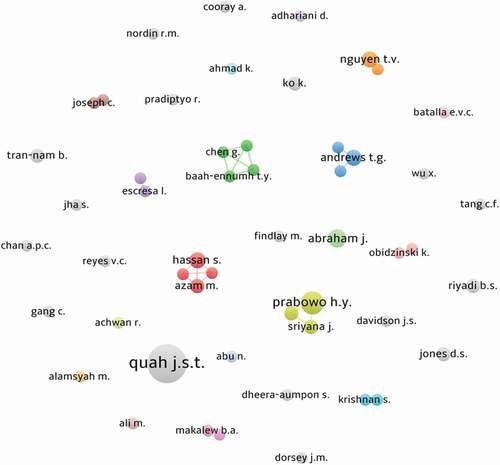
3.7. The most influential articles
List of the top 10 most cited papers in the publication collection of 631 papers is shown in , along with their numbers of citations over the last decade. The total number of citations of the top 10 papers is 1198 which corresponds to 26% of the total citations of the collection at the time of this study (4610 citations). The article studying corruption in selling anti-malarials in several Southeast Asian countries ranked first, with 169 citations (Dondorp et al., Citation2004). Ranked second on the list is a research investigating whether better corruption control would help form the inverted U-shaped relationship between income and pollution in Cambodia (Ozturk & Al-Mulali, Citation2015). Eight of these top 10 papers were conducted and published with the first author from ASEAN countries. Singapore, Indonesia and Thailand, each country has two representatives, whereas, Thailand and Vietnam, each has one representative. The remaining two papers have the first author from Turkey and France.
Table 6. Overview of the top 10 most cited papers in the publication collection
The historical direct citation network of the 30 most locally cited articles in the publication collection is illustrated in . Each node represents a paper, and the lines between nodes indicate a direct citation between two papers. The historical direct citation network is very useful in identifying the core papers, as well as all papers related to a certain research direction. Several papers listed in can also be found in , for example, Smith et al. (Citation2003), Wu (Citation2005), Alatas et al. (Citation2009), and Nguyen and van Dijk (Citation2012). Some authors in the top 10 most productive scholars in also have several papers listed in , for instance, Quah JST, Prabowo HY, and Nguyen TV.
Figure 7. Historical direct citation network of the 30 most local cited papers in the publication collection. Each no represents a paper and each edge represents a direct citation. Nodes and edges are plotted on an oriented graph where the horizontal axis represents the publication years. Artwork was generated with Biblioshiny tool

3.8. Keywords and terms analysis
Co-occurrence network of 85 most popular keywords, which appeared at least five times, is presented in . Each keyword is represented by a node, and the thickness of lines between two nodes is proportional to the strength of the relationship between them. This relationship was determined by the number of times they appeared together in published papers of the publication collection. Note that the keyword “corruption” was removed from the list as it appeared in most of the publications in the collection. Keywords representing names of ASEAN countries (Indonesia, Malaysia, Philippines, Thailand, Vietnam …) were also removed from the list of keywords to generate because these keywords mostly indicate the study areas. Through , some of the most important keywords (or research topics) related to corruption study in ASEAN can be identified. Crime was the most popular keyword. This is as expected because corruption is normally linked to crime. Keywords Asia, Eurasia, Southeast Asia are visible which indicates that these regions were mainly the study areas of articles in the collection. Interestingly, keyword Bangladesh is also visible as there were several papers investigating corruption in Bangladesh, for example, Uddin et al. (Citation2020), Asadullah and Chakravorty (Citation2019), Parnini and Othman (Citation2013), Parnini (Citation2009), and Naeem and Welford (Citation2009). In addition, these studies on corruption in Bangladesh were conducted mainly by Malaysian scholars. Corruption studies in China were also popular topics. A few papers published recently can be listed, for instance, (Vyas & Wu, Citation2020), (Hope et al., Citation2020), or (Shan et al., Citation2017). These researches related to corruption in China were mainly conducted with collaboration between Singaporean and Hong Kong scholars. Other popular research themes in corruption can be identified, such as anti-corruption, corruption in governance, corruption related to the foreign direct investment, corruption in economics and business, corruption in education, and corruption related to law enforcement and public sector. Close and related keywords (or research topics) were classified and grouped into one of six clusters as shown in . Cluster 1 (violet) includes topics related to crime, and research methods for anti-corruption and transparency. Cluster 2 (yellow) includes articles focusing on corruption in China, whereas cluster 3 (pink) includes articles focusing on corruption in Southeast Asian countries and Bangladesh. Cluster 4 (blue) includes articles focusing on governance approach to control corruption in developing countries and growing economies. Cluster 5 (red) includes articles related to education for corruption prevention for human being, while other topics are grouped in cluster 6 (green).
3.9. Thematic map of research topics
shows the co-occurrence network of the most popular keywords, but does not show the development of these research topics over time. For example, a few topics might have been popular in the past, but they did not receive much attention in recent years. The thematic map in divides the most important research topics into four different typologies of themes, based on their levels of centrality and density. Centrality measures the strength of external ties to other themes. This value can be understood as a measure of the importance of the theme in the development of the entire research field. On the other hand, density measures the strength of internal ties among all keywords describing the research theme. This value can be understood as a measure of the theme’s development (Callon et al., Citation1991). Motor themes displayed in the upper-right quadrant are defined as high centrality and high density. Therefore, motor themes are very important research topics. Anti-corruption, corruption related to ethics and Islam are classified into this quadrant. The upper-left quadrant contains topics having high density but low centrality. These topics are defined as highly developed but isolated. Corruption prevention, corruption related to foreign direct investment and poverty are classified into this quadrant. Emerging or declining research topics are classified into the lower-left quadrant as these topics have both low density and centrality. Control of corruption is classified into this quadrant. Finally, basic and transversal research topics with high centrality are classified into the lower-right quadrant. Many keywords are grouped into this quadrant, including transparency, political corruption, and corruption related to governance, democracy, bribery, and education. China, Indonesia, and Malaysia are confirmed to be the most transversal study areas of the collection.
4. Discussion and conclusion
The annual number of publications increased very slowly during the first sub-period (2000–2010), but steadily during the second sub-period (2011–2020) when 85.6% of the publication collection was published (). This increase of interest in corruption-related research in the second sub-period corresponds to the gradual recovery of Southeast Asian economies from the global financial crisis of 2008. A spike in the scientific output can be observed in 2020 when 28.6% of the papers was published in this year (n = 160), almost doubled the output of the previous year (n= 84). This finding suggests that the number of publications in this field might increase more rapidly in coming years. However, the development of scientific output was uneven among ASEAN member countries (—pie chart). Indonesia, Malaysia, and Singapore have the biggest contribution as each country participated in at least 20% of the papers in the collection. As a consequence, the top 10 institutions publishing in this research field all came from these three countries (), as well as eight out of the 10 most productive scholars (). The second group includes Thailand, Vietnam, and the Philippines as each country contributed less than 10% of the papers in the collection. It is important to mention that the ASEAN states that have produced the most number of publications on corruption are also the same states that have the highest GPD per capital in Southeast Asia. The four remaining ASEAN countries were in the last group as their scientific output in this research field was very limited. If scholars from countries in the last group do not improve their performance, then the gap with countries in the other two groups will become much larger. The increase in the number of publications from Vietnam in 2020 was remarkable with 26 papers, which accounted for 53% of the papers from this country, and 16.25% of all papers published in 2020. This increase placed Vietnam in the third position in 2020 based on the number of publications, after Indonesia and Malaysia (—bar chart). This development needs to be observed in the coming years to be able to conclude if it was just an abnormal phenomenon or it was a result of new anti-corruption policies from the Vietnam government (Vietnam-National-Assembly, Citation2018).
International collaboration network in this research field between scholars from ASEAN countries and partner countries was not very strong. The US, the UK and China, the Netherlands and Hong Kong were the five most important partner countries; however, these countries only participated in 16% of the publications. Except for the UK, the four other countries are always among the top investors who provided significant amounts of FDI to Southeast Asian countries (ASEAN, Citation2021). In addition, the cooperation network within scholars within ASEAN countries was very limited. As seen in , only Indonesia and Vietnam were classified in the same group as they had some joint publications. Singapore, Malaysia, Thailand and Philippines were alone in separate groups because they had limited joint research with other scholars from ASEAN countries. The isolation in conducting research in this field is clearer in where we showed the co-authorship network between all authors with at least three papers. It is obvious that most of these scholars were isolated without connection with other researchers. Quah JST was the most productive scholar with 21 papers (3.3%) and 226 citations (4.9%), but this author only published single-authored document. A few research teams can be identified in Indonesia, Malaysia, Thailand and Vietnam, but these teams did not have any connection with other teams, and the number of team members did not exceed four. Isolated scholars tend to have fewer publications (Pham-Duc, Tran et al., Citation2020); therefore, it is very important to build large and strong collaboration networks not only in this field but also in all research fields because it will help scholars to improve and boost their scientific output. As the number of conference papers was still low (—pie chart), organizing international conferences could be a good way to help scholars to achieve this objective. In addition, scholars should also improve the quality of their future work as there were only three Q1 journals in the top 10 most popular ones.
Eight out of ten most cited papers had the first author’s affiliation located in one of the ASEAN member countries (), suggesting that local scholars had major contribution to the publication collection. Among the top 10 papers in , six were published in the first sub-period, and four in the second sub-period. Most publications from the top 10 most productive scholars were published during the second sub-period (), which explains why there are only two papers in having co-authors listed (Azam et al., Citation2013; Krishnan et al., Citation2013). It is expected that the influence of the top 10 will increase in coming years as nearly one-third of the papers in the historical direct citation network have been published by these scholars (). The historical direct citation network is also helpful in detecting the most important papers in the collection, as well as the most popular research themes over time. Young researchers and newcomers might find this information valuable at the beginning of their carrier in this research field.
Keywords analyses and thematic map of keywords in indicated that the research topics were diverse, focusing on corruption in different sectors such as education, economics, government, construction industry, foreign direct investment, and anti-corruption. Among these themes, anti-corruption was the most important research topic, while the most popular ones focused on transparency, bribery, and corruption in education and political corruption. It is well recognized that science can influence public policy (Mesthene, Citation1967; Montuschi, Citation2017). Therefore, if Southeast Asian scholars can conduct and publish excellent research articles on high ranking journals, it might have direct impact on decision-makers and governments on making strategies for fighting with corruption and improving transparency. We suggest that Southeast Asian scholars should build stronger collaboration networks with other scholars, both inside and outside the region, to be able to develop joint research directions with excellent scientific output to meet the standards of high-ranking international journal in the field. Organizing international conferences could be a way to quickly achieve this objective.
To summarize, this study used bibliographic data from the Scopus database during the 2000–2020 period to investigate the development of research related to corruption studies published by scholars having affiliations located in one of the ASEAN countries. Our main findings are listed as follows: 1) the number of publications increased, but mostly during the second sub-period (2011–2020), but this development occurred at different levels among ASEAN member countries. Indonesia, Malaysia and Singapore were in the first group, followed by Thailand, Vietnam and Philippines. 2) The US, the UK and China were among the most productive partner countries, but the strength of collaboration was still very limited. 3) Collaboration between scholars was weak as there were just a few strong research groups located in a few ASEAN states, and most of the scholars were very isolated without connections with others. 4) Research topics were diverse, focusing on corruption in different sectors, and anti-corruption was always among the most popular research directions.
5. Limitations
This study faces similar limitations that were already reported in previous papers (Ha et al., Citation2020; Pham-Duc, Tran et al., Citation2020). First, using only bibliographic data from the Scopus database might not include all publications in the literature related to corruption conducted by scholars from ASEAN countries. Second, manually filtering the irrelevant papers in different Scopus categories might not have been perfect, and omissions might have occurred. Third, certain types of information like author names and author institutions are not standardized in the Scopus database. As manual correction is not possible, this might have affected our results as our analyses totally dependent on the quality of the input information imported from the Scopus database. Fourth, certain types of analyses, for instance, statistic of scholars by genders, cannot be done in this study due to technical limitations of the Biblioshiny and VOSviewer tools. Advantages of other bibliographic analysis tools, such as SciMAT (Cobo et al., Citation2012), combined with bibliographic information from other databases should be investigated to optimize this type of research in the future.
Acknowledgements
The authors would like to thank the developers of the VOSviewer tool, Nees Jan van Eck and Ludo Waltman, and the developers of the Biblishiny tool, Massimo Aria and Corrado Cuccurollo, for developing these tools to enable the data processing and data visualization used in this study. We thank our colleague, Dr. Binh Pham-Duc, for his valuable suggestions on our manuscript. We would like to thank the editor and the reviewers who provided valuable comments that improved the quality of our manuscript.
Disclosure statement
No potential conflict of interest was reported by the author(s).
Data availability statement
The data that support the findings of this study are available from Elsevier’s Scopus database. Restrictions apply to the availability of these data, which were used under license for this study. Data are available from the authors with the permission of Scopus.
Additional information
Funding
Notes on contributors
Dung Quoc Bui
Dr. Dung Quoc Bui is Head of Scientific Research Management Department, the People’s Police Academy of Vietnam. His main research are management science, education science, security science, and scientific research skills.
Sy Tien Bui
Dr. Sy Tien Bui manages scientific research at the People’s Police Academy of Vietnam. He is an expert in the field of criminology research and criminal.
Nga Kim Thi Le
Dr. Nga Kim Thi Le works at the People’s Police Academy of Vietnam. Her work focuses on the theory of crime prevention and combat.
Lan Mai Nguyen
Dr. Lan Mai Nguyen is chairwoman of Nguyen Tat Thanh University Council, Vietnam. Her work focuses on interdisciplinary researches between economics, management, technology, and the development of scientific research skills.
Tung The Dau
Dr. Tung The Dau works at the Vietnam Academy for Ethnic Minorities. His main research interest are state and public management, and student and education management.
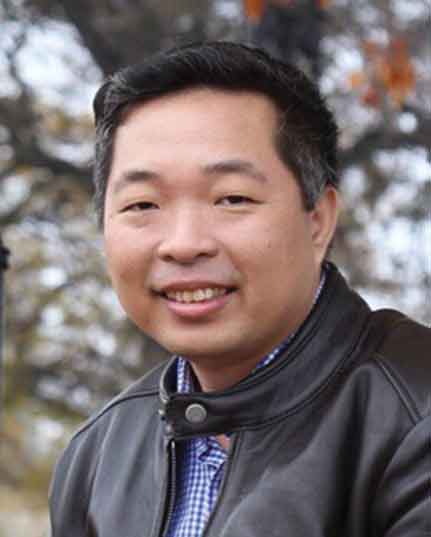
Trung Tran
Dr. Trung Tran is Director of the Vietnam Academy for Ethnic Minorities. His main research areas are ethnic education, educational management, public policy, and teaching methods.
References
- Alatas, V., Cameron, L., Chaudhuri, A., Erkal, N., & Gangadharan, L. (2009). Gender, culture, and corruption: Insights from an experimental analysis. Southern Economic Journal, 75(3), 663–27. https://doi.org/10.1002/j.2325-8012.2009.tb00925.x
- Alavifard, S. (2015). H-Index Calculator using Data from a Web of Science (WoS) Citation Report [R package h index calculator version 1.0.0]. Comprehensive R Archive Network (CRAN). https://cran.r-project.org/package=hindexcalculator
- Asadullah, M. N., & Chakravorty, N. N. T. (2019). Growth, governance and corruption in Bangladesh: A re-assessment. Third World Quarterly, 40(5), 947–965. https://doi.org/10.1080/01436597.2019.1599854
- ASEAN. (2021). ASEAN Investment Report 2020–2021 – Investing in Industry 4.0. https://asean.org/wp-content/uploads/2021/09/AIR-2020-2021.pdf
- Azam, M., Hassan, S., & Khairuzzaman. (2013). Corruption, workers remittances, Fdi and economic growth in five South and South East Asian countries: A panel data approach. Middle East Journal of Scientific Research, 15(2), 184–190. https://doi.org/10.5829/idosi.mejsr.2013.15.2.2284
- Bahoo, S., Alon, I., & Floreani, J. (2021). Corruption in economics: A bibliometric analysis and research agenda. Applied Economics Letters, 28(7), 565–578. https://doi.org/10.1080/13504851.2020.1764476
- Bahoo, S. (2020). Corruption in banks: A bibliometric review and agenda. Finance Research Letters, 35, 101499. https://doi.org/10.1016/j.frl.2020.101499
- Brada, J. C., Drabek, Z., & Perez, M. F. (2012). The effect of home-country and host-country corruption on foreign direct investment. Review of Development Economics, 16(4), 640–663. https://doi.org/10.1111/rode.12009
- Broadus, R. N. (1987). Toward a definition of “bibliometrics.”. Scientometrics, 12(5–6), 373–379. https://doi.org/10.1007/BF02016680
- Callon, M., Courtial, J. P., & Laville, F. (1991). Co-word analysis as a tool for describing the network of interactions between basic and technological research: The case of polymer chemsitry. Scientometrics, 22(1), 155–205. https://doi.org/10.1007/BF02019280
- Cobo, M. J., Lõpez-Herrera, A. G., Herrera-Viedma, E., & Herrera, F. (2012). SciMAT: A new science mapping analysis software tool. Journal of the American Society for Information Science and Technology, 63(8), 1609–1630. https://doi.org/10.1002/asi.22688
- Deflem, M. (1995). Corruption, Law, and Justice: A Conceptual Clarification. Journal of Criminal Justice, 23(3), 243–258. https://doi.org/10.1016/0047-2352(95)00018-L
- Dondorp, A. M., Newton, P. N., Mayxay, M., Van Damme, W., Smithuis, F. M., Yeung, S., Petit, A., Lynam, A. J., Johnson, A., Hien, T. T., McGready, R., Farrar, J. J., Looareesuwan, S., Day, N. P. J., Green, M. D., & White, N. J. (2004). Fake antimalarials in Southeast Asia are a major impediment to malaria control: Multinational cross-sectional survey on the prevalence of fake antimalarials. Tropical Medicine and International Health, 9(12), 1241–1246. https://doi.org/10.1111/j.1365-3156.2004.01342.x
- Everett, J., Neu, D., & Rahaman, A. S. (2007). Accounting and the global fight against corruption. Accounting, Organizations and Society, 32(6), 513–542. https://doi.org/10.1016/j.aos.2006.07.002
- Gaillard, J.-C., Liamzon, C. C., & Villanueva, J. D. (2007). “Natural” disaster? A retrospect into the causes of the late-2004 typhoon disaster in Eastern Luzon, Philippines. Environmental Hazards, 7(4), 257–270. https://doi.org/10.1016/j.envhaz.2006.11.002
- Ha, C. T., Thi, T., Thao, T. T. P., Trung, N. T., Huong, L. T. T., Dinh, N. V., & Trung, T. (2020). A bibliometric review of research on STEM education in ASEAN: Science mapping the literature in Scopus Database, 2000 to 2019. Eurasia Journal of Mathematics, Science and Technology Education, 16(10), 11 pp. https://doi.org/10.29333/ejmste/8500
- Hallinger, P., & Chatpinyakoop, C. (2019). A bibliometric review of research on higher education for sustainable development, 1998–2018. Sustainability, 11(8), 2401. https://doi.org/10.3390/su11082401
- Hope, O.-K., Yue, H., & Zhong, Q. (2020). China’s anti-corruption campaign and financial reporting quality. Contemporary Accounting Research, 37(2), 1015–1043. https://doi.org/10.1111/1911-3846.12557
- Johnston, M. (1986). The political consequences of corruption: A reassessment. Comparative Politics, 18(4), 459–477. https://doi.org/10.2307/421694
- Keyuan, Z. (2000). Judicial reform in China: Recent developments and future prospects. The International Lawyer, 36(3), 1039–1062. http://www.jstor.org/stable/40707698
- Krishnan, S., Teo, T. S. H., & Lim, V. K. G. (2013). Examining the relationships among e-government maturity, corruption, economic prosperity and environmental degradation: A cross-country analysis. Information and Management, 50(8), 638–649. https://doi.org/10.1016/j.im.2013.07.003
- Li, Y., Xu, Z., Wang, X., & Wang, X. (2020). A bibliometric analysis on deep learning during 2007–2019. International Journal of Machine Learning and Cybernetics, 11(12), 2807–2826. https://doi.org/10.1007/s13042-020-01152-0
- Mesthene, E. G. (1967). The impacts of science on public policy. Public Administration Review, 27(2), 97–104. https://doi.org/10.2307/974142
- Mijares, S. C. (2015). The global fight against foreign bribery: Is Canada a leader or a laggard? Western Journal of Legal Studies, 5(4), 2 https://ir.lib.uwo.ca/uwojls/vol5/iss4/2.
- Mongeon, P., & Paul-Hus, A. (2016). The journal coverage of Web of Science and Scopus: A comparative analysis. Scientometrics, 106(1), 213–228. https://doi.org/10.1007/s11192-015-1765-5
- Montuschi, E. (2017). Using science, making policy: What should we worry about? European Journal for Philosophy of Science, 7(1), 57–78. https://doi.org/10.1007/s13194-016-0143-3
- Moral-Muñoz, J. A., Herrera-Viedma, E., Santisteban-Espejo, A., & Cobo, M. J. (2020). Software tools for conducting bibliometric analysis in science: An up-to-date review. El Profesional de La Información, 29(1). https://doi.org/10.3145/epi.2020.ene.03
- Naeem, M. A., & Welford, R. (2009). A comparative study of corporate social responsibility in Bangladesh and Pakistan. Corporate Social Responsibility and Environmental Management, 16(2), 108–122. https://doi.org/10.1002/csr.185
- Nguyen, T. T., & van Dijk, M. A. (2012). Corruption, growth, and governance: Private vs. state-owned firms in Vietnam. Journal of Banking and Finance, 36(11), 2935–2948. https://doi.org/10.1016/j.jbankfin.2012.03.027
- Ozturk, I., & Al-Mulali, U. (2015). Investigating the validity of the environmental Kuznets curve hypothesis in Cambodia. Ecological Indicators, 57, 324–330. https://doi.org/10.1016/j.ecolind.2015.05.018
- Pantzalis, C., Park, J. C., & Sutton, N. (2008). Corruption and valuation of multinational corporations. Journal of Empirical Finance, 15(3), 387–417. https://doi.org/10.1016/j.jempfin.2007.09.004
- Parnini, S. N., & Othman, M. R. (2013). Democratic consolidation and credibility of governance institutions in Bangladesh. Journal of Asian and African Studies, 49(1), 34–48. https://doi.org/10.1177/0021909612471789
- Parnini, S. N. (2009). Public sector reform and good governance: The impact of foreign aid on Bangladesh. Journal of Asian and African Studies, 44(5), 553–575. https://doi.org/10.1177/0021909609338903
- Pham-Duc, B., Nguyen, H., Le Minh, C., Khanh, L. H., & Trung, T. (2020). A bibliometric and content analysis of articles in remote sensing from vietnam indexed in Scopus for the 2000–2019 period. Serials Review, 46(4) , 275–285. https://doi.org/10.1080/00987913.2020.1854155
- Pham-Duc, B., Tran, T., Le, H.-T.-T., Nguyen, N.-T., Cao, H.-T., & Nguyen, -T.-T. (2021). Research on Industry 4.0 and on key related technologies in Vietnam: A bibliometric analysis using scopus. Learned Publishing, 34(3), 414–428. https://doi.org/10.1002/leap.1381
- Pham-Duc, B., Tran, T., Trinh, T.-P.-T., Nguyen, T.-T., Nguyen, N.-T., & Le, H.-T.-T. (2020). A spike in the scientific output on social sciences in Vietnam for recent three years: Evidence from bibliometric analysis in Scopus database (2000–2019). Journal of Information Science, 0165551520977447. https://doi.org/10.1177/0165551520977447
- Quah, J. S. T. (2001a). Combating corruption in Singapore: What can be learned? Journal of Contingencies and Crisis Management, 9(1), 29–35. https://doi.org/10.1111/1468-5973.00151
- Quah, J. S. T. (2001b). GLOBALIZATION AND CORRUPTION CONTROL IN ASIAN COUNTRIES: The case for divergence. Public Management Review, 3(4), 453–470. https://doi.org/10.1080/14616670110071838
- Saeed, M., Ahmed, Z. U., & Mukhtar, S.-M. (2001). International marketing ethics from an Islamic perspective: A value-maximization approach. Journal of Business Ethics, 32(2), 127–142. https://doi.org/10.1023/A:1010718817155
- Scopus Preview. (2021). Scopus. Retrieved October 29, 2021, from http://www.scopus.com
- Seetharaman, A., Senthilvelmurugan, M., & Periyanayagam, R. (2004). Anatomy of computer accounting frauds. Managerial Auditing Journal, 19(8), 1055–1072. https://doi.org/10.1108/02686900410557953
- Sforza, V., Cimini, R., Mechelli, A., & Vian, T. (2020). A review of the literature on corruption in healthcare organizations International Journal of Business and Management, 15(4), 98–111. https://doi.org/10.5539/ijbm.v15n4p98
- Shan, M., Le, Y., Yiu, K. T. W., Chan, A. P. C., & Hu, Y. (2017). Investigating the underlying factors of corruption in the public construction sector: Evidence from China. Science and Engineering Ethics, 23(6), 1643–1666. https://doi.org/10.1007/s11948-016-9865-z
- Shihata, I. F. I. (1997). Corruption: A general review with an emphasis on the role of the World Bank. Journal of Financial Crime, 5(1), 12–29. https://doi.org/10.1108/eb025812
- SJR. (2021). Scimago journal & country rank. Retrieved October 29, 2021, from https://www.scimagojr.com/
- Smith, J., Obidzinski, K., Subarudi, & Suramenggala, I. (2003). Illegal logging, collusive corruption and fragmented governments in Kalimantan, Indonesia. The International Forestry Review, 5(3), 293–302. https://doi.org/10.1505/IFOR.5.3.293.19138
- Srivastava, S. C., Chandra, S., & Teo, T. S. H. (2007). E-government and corruption: A cross-country analysis. In Twenty Eighth International Conference on Information Systems. ScholarBank@NUS Repository.
- Uddin, M. J., Hossain, F., Fujimoto, Y., & Ahmed, J. U. (2020). Do public sector organizations ensure labor ethics? Perspectives from ethics and workplace spirituality in Bangladesh’s garment sector. Public Administration and Development, 40(3), 168–178. https://doi.org/10.1002/pad.1874
- Uribe-Toril, J., Ruiz-Real, J. L., Ceresia, F., & Valenciano, J. (2019). Corruption and entrepreneurship: A bibliometric analysis. Journal of Legal, Ethical and Regulatory Issues, 22(4), 1–11. https://www.abacademies.org/articles/corruption-and-entrepreneurship-a-bibliometric-analysis-8512.html
- van Eck, N. J., & Waltman, L. (2010). Software survey: VOSviewer, a computer program for bibliometric mapping. Scientometrics, 84(2), 523–538. https://doi.org/10.1007/s11192-009-0146-3
- Vietnam-National-Assembly. (2018). Anti-corruption law. https://thuvienphapluat.vn/van-ban/Bo-may-hanh-chinh/Luat-Phong-chong-tham-nhung-322049.aspx
- Vyas, L., & Wu, A. M. (2020). Anti-Corruption policy: China’s tiger hunt and India’s demonetization. International Journal of Public Administration, 43(11), 1000–1011. https://doi.org/10.1080/01900692.2020.1739071
- Wu, X. (2005). Corporate governance and corruption: A cross-country analysis. Governance, 18(2), 151–170. https://doi.org/10.1111/j.1468-0491.2005.00271.x

